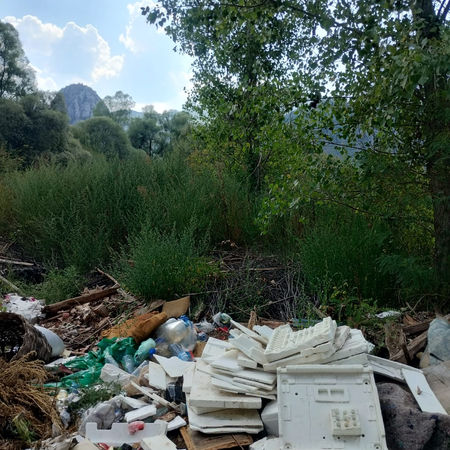
Towards sustainable waste management in SRP Jerma: the first models of cooperation and changing practices
The Jerma Special Nature Reserve, one of the most valuable protected areas in southeastern Serbia, faces numerous challenges when it comes to municipal and bulky waste management. For decades, the lack of a systematic solution for waste disposal in the villages inside the reserve led to the emergence of more wild landfills - often near water sources, forests and habitats of protected species.
One of the most visible examples was the illegal landfill in the village of Vlasi, located right next to the habitat of the Great Marmot (Triturus macedonicus) - a strictly protected species in Serbia and Europe. This ecologically and symbolically important case was the reason for launching a wider project of responsible waste management on the territory of the reserve.
Removal of the landfill - the beginning of concrete change
In cooperation between the association Jerma , Srbijašum (as the manager of the reserve), Pirot Regional Landfill , JP Komunalac Pirot , the Institute for Nature Protection of Serbia and the Institute for Biological Research "Siniša Stanković" , a complete rehabilitation of the landfill in Vlasa was successfully organized in 2025. This act initiated the process of ecological restoration of the local habitat, but also a model that can serve as an example for other protected areas.
The role of the Pirot Regional Landfill - an example of good practice
It is important to emphasize that the Pirot Regional Landfill , apart from logistical and technical support, has shown exceptional willingness to participate in solving specific problems of protected areas, which is not always in the domain of regular obligations of communal systems. Through the cooperation on this project, the landfill stood out as a partner with the capacity for customized and responsible solutions - which is extremely important in the context of the climate and environmental challenges faced by rural areas as well.
Container for bulky waste and the action "Clean your home"
Immediately after the removal of the landfill, the village of Vlasi received a container for bulky waste for the first time, which will be installed every three months and will remain in the village for one week . Locals thus get the opportunity to properly and safely dispose of bulky waste - without additional burden on the environment.
Also, as part of the action "Clean your home" , which will be organized in cooperation with the Pirot Regional Landfill, the landfill truck will come directly to the village at the announced time, where residents can take out and load all bulky waste. This model of the Regional Landfill has already received an extremely positive response in other villages in the course of implementation so far and is becoming an important instrument for changing habits in waste management in the countryside.
Systematic approach: mapping and rehabilitation plan of all landfills
The Jerma Association has started mapping all illegal garbage dumps and wild dumps in the villages of the reserve - regardless of their administrative affiliation. Based on the collected data, an operational remediation plan will be drawn up, which will be implemented in cooperation with the Regional Landfill Pirot , Srbijašume , local self-governments and volunteer teams of the association. The goal is not only the removal of existing landfills, but also the prevention of their recurrence through the establishment of long-term systems and education of the population.
Rounding off the process: arranging the Great Marmot's habitat
In the final phase of this model, in cooperation with the Institute for Biological Research "Siniša Stanković" , the arrangement and revitalization of wet habitats is planned, with a focus on the survival of the Great Marmot. In this way, the project does not remain exclusively in the domain of communal or infrastructural intervention, but is rounded into a complete process of ecological restoration .
Conclusion
The project to establish responsible waste management in SRP Jerma shows how concrete problems can be solved with the synergy of the local community, the manager of the protected area, scientific institutions and communal structures.
Special thanks goes to the Pirot Regional Landfill , which showed that communal systems, when they function proactively and are open to cooperation, can play a key role in protecting nature and improving the quality of life even in the most remote areas.
This model can already serve as an example of good practice , and its continuation and expansion could bring a systemic change in the treatment of waste within protected natural areas throughout Serbia.




